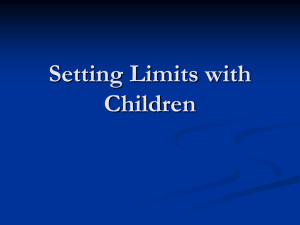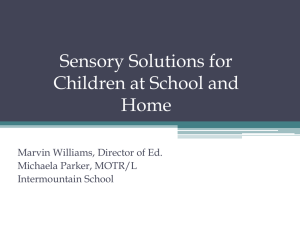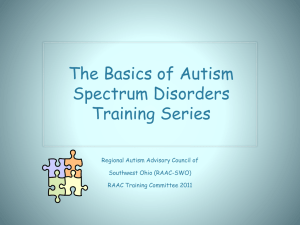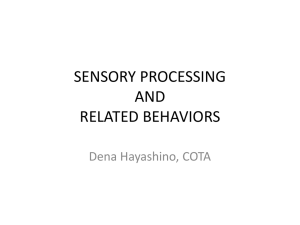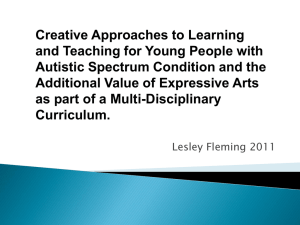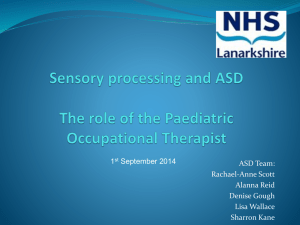Sensory & Motor Differences in Children Diagnosed with ASD
advertisement
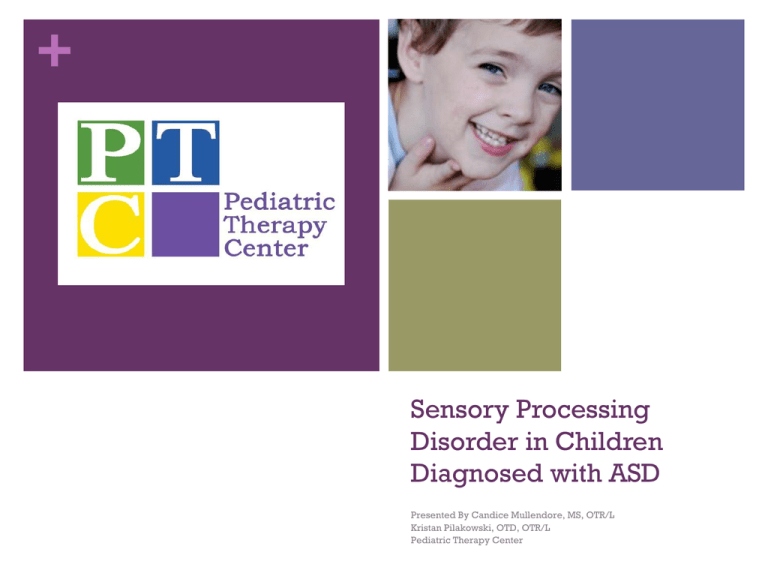
+ Sensory Processing Disorder in Children Diagnosed with ASD Presented By Candice Mullendore, MS, OTR/L Kristan Pilakowski, OTD, OTR/L Pediatric Therapy Center + Course Objectives Understand and recognize common fine motor and gross motor disturbances associated with an ASD diagnosis Understand and recognize motor planning issues in children diagnosed with ASD Understand and recognize the signs and behaviors associated with sensory processing differences and ASDs Understand the unique sensory needs and challenges of a child diagnosed with ASD Understand the principles of intervention for sensory and motor disturbances and the role of occupational and physical therapy + Nationally, approximately 1.5 million people are affected by autism Since 1993 there has been a 7,000% increase in children with a diagnosis of autism in the state of NE that are served by IDEA (http://whale.to/a/autism_increase.html) + Symptoms Associated with an ASD Diagnosis Social Interaction Disturbance Speech, language, and/or communication impairments or deficits Stereotyped or repetitive behaviors Cognitive skills What’s missing? + Motor Disturbances and ASD Wide range of motor deficits and impairments associated with ASD Fine Motor Deficits Gross Motor Deficits Difficulties with Motor Planning + Fine Motor Deficits with ASD Often have delays in the development of mature grasping patterns Difficulty with handwriting Difficulty managing fasteners + Gross Motor Disturbances with ASD Parents commonly report gross motor milestones met early or in typical range Often have abnormal gait patterns (toe walking) Clumsy even in familiar environments Difficulty with more complex or advanced motor patterns Difficulty with organized sports Poor body awareness + Motor Planning Deficits with ASD Dyspraxia: impairment of the development of purposeful, voluntary movement Sometimes called Developmental Coordination Disorder Difficulty with more complex or multi-step motor plans Independent dressing Brushing teeth Using utensils Tying shoes Using scissors Riding a bike + Motor Planning Deficits Motor deficits are often related to sensory processing differences Poor body awareness Poor spatial awareness Poor tactile processing Poor vestibular processing Often overlooked Not considered priority for treatment Can and should be treated with occupational and physical therapy + Sensory Processing Defined Sensory processing (sometimes called "sensory integration" or SI) is a term that refers to the way the nervous system receives messages from the senses and turns them into appropriate motor and behavioral responses. Whether you are biting into a hamburger, riding a bicycle, or reading a book, your successful completion of the activity requires processing sensation or "sensory integration." -SPD Foundation + Sensory Integration… This concept originated out of the work of A. Jean Ayers Her focus was on the role of sensory processing in child development Proximal senses – vestibular, tactile, and proprioceptive senses Distal senses – vision and hearing First defined sensory integration as “the organization of sensation for use” + Sensory Integration… Is an unconscious process of the brain Organizes information detected by the senses Gives meaning to what is experienced by sifting through all the incoming information and prioritizing what to focus on Allows us to act on or respond to the situation we are experiencing in a purposeful manner Forms the underlying foundation for academic learning and social behavior + Sensory Processing Hierarchy COGNITIVE PROCESSING LANGUAGE PROCESSING EMOTIONAL PROCESSING SENSORY PROCESSING + Brain Food Sensory integration is the most important type of sensory processing Sensations nourish the brain by providing the knowledge to direct the body and mind for functional activities Without well organized sensory processes, sensations cannot be digested and nourish the brain + Directing Traffic The brain must locate, sort, and organize all incoming sensory input When sensations flow in a well organized and integrated manner, the brain can use those sensations to form perceptions, behaviors, and learning When disorganized, everyday life can feel like a traffic jam + Sensory Modulation The nervous system modulates itself by increasing the energy of certain messages and reducing the energy of others Every sensory and motor process involves facilitory and inhibitory forces to help useful messages along and prevent those that are not useful from getting in the way + Modulation Without sufficient inhibition, sensory impulses would spread rapidly through the nervous system. This would cause the person to become extremely overwhelmed Sensory modulation is a critical part of sensory integration that should be mastered early in childhood to allow for more advanced sensory processing later in life + 18 Hypersensitivity Sensations are registered too intensely Sensory information is over stimulating and can be irritating, annoying, or threatening Unable to screen relevant information Highly distractible + 19 Hyposensitivity Registers sensations less intensely than normal Does not get enough input to process sensory information accurately May seek extra input or be passive and sluggish + 20 Combination Hypo-Hypersensitivity Oversensitive in some ways and under sensitive in others Poor modulation May seek certain input at times and avoid it at others Can vary with each day or with each activity ADHD diagnosis is common 21 + 22 Keep in Mind… Child with SPD will not have every characteristic Symptoms can very between or within each day – inconsistency is a hallmark of neurological dysfunction Children can be both hyper and hyposensitive No one is well regulated all the time + Putting the Pieces Together… Eating an orange Use your eyes, nose, mouth, the skin on your hands and fingers, muscles, joints, and tendons inside your fingers, hands, and arms, and your mouth Sensory integration: all the sensory information comes together to allow us to peel, eat, and enjoy eating an orange + Adaptive Responses A purposeful, goal directed response to a sensory experience Mastering a challenge and learning something new Examples: Waving arms vs. reaching for an object Perceiving that a toy is too far away and crawling to get it Learning to tie your shoe + SPD and Autism Three common problems in children with Autism and SPD Sensory input is not being “registered” correctly – leads to paying little attention to some things and at times overreacting Inaccurate or poor modulation of sensory input – especially vestibular and tactile sensations leading to gravitational insecurity and tactile defensiveness The part of the brain that motivates interest in new and different activities is not operating correctly causing little or no interest in purposeful or constructive tasks + SPD and Autism Other common behaviors and signs Little or no registration of odors Little sense of taste Poor body awareness Poor pain perception Intense awareness of tactile stimuli – light touch defensiveness Restricted diets Movement seeking or “on-the go” + SPD and Autism Poor registration leads to inaccurate integration Impacts the ability to form a clear perception of space and a child’s relationship to space Trouble registering spatial elements of their environment often leads to great difficulty when things within their environment change Poor registration from skin, muscles, joints, and vestibular system impact body awareness and motor planning – impair ability to interact with the world + SPD and Autism Difficulty with postural responses Although not well developed, they are better than most children with a diagnoses of only SPD Indicates the brain stem is processing proprioceptive and vestibular input needed for postural responses Dyspraxia Difficulty locating tactile stimuli Difficulty knowing where their hands are if they cannot see them + SPD and Autism Differences in the Limbic System Leads to inaccurate registration of sensory information and failing to register and record input Sorting through relevant and irrelevant visual input, may fail to visually attend to facial expressions but will pay unusual attention to a small detail such as a spot on the floor + SPD and Autism Other common behaviors and signs Little or no registration of odors Little sense of taste Poor body awareness Poor pain perception Intense awareness of tactile stimuli – light touch defensiveness Restricted diets + SPD and Autism “I want to do it” Many children with autism are missing this internal motivator or desire to initiate behavior The outcome of sensory input is deciding to respond or ignore sensory stimuli Impacts purposeful and/or functional play and actions Properly registering and integrating sensory input provides information for interaction with the environment + SELF CHECK Are you chewing gum? Are you wiggling your foot or leg? Have you been snacking during the session? Are you tapping your pen on the table? Have you ever turned down the radio in the car when it is dark and raining and you are lost? + The 5 Senses Exteroceptors – sensations that tell us what is going on outside of the body Sight Sound Taste Smell Touch + Beyond the 5 Senses Proprioceptors – sensations that tell us where the body is in space and how it is moving Proprioception – position and movement Vestibular sense – gravity, head movement, and balance + + Signs of SPD - Auditory Under-responsive: Hums or makes other noises constantly Misses oral instructions more often than other students Appears to ignore instructions frequently Seems oblivious within an active environment Over-responsive: Avoidance behaviors before he/she has to go to Music, PE, or lunch Comments about the fire engine or plane outside that no one else has noticed Overly scared of fire alarm during fire drills Frequently tells others to be quiet + Auditory Treatment Ideas Earplugs Headphones without the music Gradual exposure to louder items Quiet place to retreat to when items are loud + Use of Therapeutic Listening™ for auditory regulation + Signs of SPD - Proprioceptive Under-responsive: Sits on other children by accident when trying to sit on the floor Trips over own feet frequently Seeks out rough and tumble play Pushes too hard through pencil Frequently rips paper when trying to write or erase Seeks out hugs Does not seem aware of own strength Sprawls across chairs and/or slouches Over-responsive Does not push hard enough through pencil when writing Does not climb on playground equipment due to apparent fear of heights Moves arms and legs slowly or stiffly Hesitant to participate in physical games + Proprioceptive Treatment Ideas Hanging from monkey or pull up bar Crash into pillows Carrying, pushing & pulling heavy items Theraband around legs of chair Brushing program Pushing/pulling heavy items Carrying heaving items Weighted vest or blanket + Proprioceptive Treatment Ideas Continued… Wrist and/or ankle weights Climbing Jumping Animal walks Crawling over dynamic surfaces Cuddle/hug vests + Proprioceptive Treatment Ideas Continued… “Hermit crab” – let your child crawl around with a heavy backpack Tug of war Bear hugs Wall/chair push ups Weighted vests and/or lap pads + Crawling through a tunnel and over cushions for proprioceptive input Weight Bearing and Handwriting for + proprioceptive input + Dynamic walking + Proprioceptive and tactile input via body sock + Signs of SPD - Vestibular Under-responsive: Wiggles in chair constantly Bumps into desks when walking through the room “Busy” or “on the go” all the time Falls frequently Shakes head frequently Climbs on furniture Hangs head upside down Over-responsive: Hesitant to participate in active or fast games/activities Intentionally withdraws from active environments or situations Doesn’t play on playground equipment, especially swings Moves slowly and cautiously Holds head/neck very stiffly + Vestibular Treatment Ideas Sitting on exercise ball Swing inside or outside Slide Jumping Animal Walks Rocking Move n sit cushions Head upside down between legs + Vestibular Treatment Ideas Continued… Swings Wagon rides Scooter board Trampoline Walking on dynamic surfaces (pillow, mattresses) Rocking chair Running Sit n spin Therapy balls Bicycle Car rides + Addressing multiple sensory components + Standing on a dynamic surface for input and core strengthening + Lying over ball to change vestibular input + Hands and knees on unstable surface + Signs of SPD - Tactile Under-responsive: Touches other children when standing in line Fidgets with small objects Gets into other people’s space when talking to them Doesn’t notice when face or hands are messy Over-responsive: Gets extremely upset when hands are messy Does not hold paper down when writing Refuses to hold items with different textures Easily upset by minor injuries (bumps, scratches, etc.) Flinches when people get in close proximity to him/her Won’t wear certain clothing items + Tactile Treatment Ideas Remove tags from clothing Velcro under the desk Texture play Rice, beans, sand, shaving cream, hair gel, dry pasta noodles, packing peanuts, shredded paper, snow, water, play doh, slime, finger paint, etc… Different fidgets for pencils, pockets, desk Play in soapy water with bowls, cups, pitchers, basters. Take water outside and “paint” different items Play with different textures Sponges, sandpaper, fabric, carpet, etc… + Tactile Treatment Ideas “Feelie” box Place sand, dried beans, rice, kitty litter, pasta, cornmeal, popcorn in Tupperware containers and bury and dig for items. “Brushing” program Fabric swatches Finger paint with different items Peanut butter, hair gel, shaving cream, pudding, etc… + Walking in different textures such as Easter grass + Shaving cream is a great tactile experience + Signs of SPD - Visual Under-responsive: Stares intensely at others Misses written or demonstrated directions more than other students Gets “off track” when filling in a busy worksheet Over-responsive: Avoids eye contact Hides under desk during transitions or “busy” times in the room Complains of headache, especially when trying to copy from the board Easily distracted by movement in the hall or out the window Can’t pay attention when in a room with lots of movement going on or lots of decorations on the walls + Visual Treatment Ideas Templates to help with homework Leave extra spaces when writing Highlighted lines Decrease visual distractions in environment No fluorescent lights Soft paint colors Bright paper taped to desk + Visual Treatment Ideas Make accommodations as necessary Tinted lenses/sunglasses Dim lighting Direct vs. indirect light White vs. pastel paper Work in a distraction free room (clear walls, covered windows) Visually organize the workspace Provide visual/picture schedule Limit time spent watching TV/movies and/or playing computer or video games Try using visual sensory toys + Tracking an object for visual practice + Tracking an object in sidelying + Signs of SPD - Olfactory Under-responsive: Brings objects to nose repeatedly Doesn’t notice strong self body odors when others do Sniffs people while in line Over-responsive: Easily distracted when lunch is being prepared Expresses distress before and/or refuses to go to cafeteria Comments on teacher’s perfume to the point of distraction Complains of headache on the bus or in the bathroom Can’t concentrate when near strong perfumes Gags when entering cafeteria at lunch time + Olfactory Treatment Ideas Unscented lotions, deodorant, laundry soap, shampoo, cleaning supplies Practice smelling different smells Start with mild smells and move towards more intense smells Spicy vs. sweet Talk through the smells with kids + Olfactory Treatment Ideas Be aware of smells that are distracting or irritating Don’t wear scented lotions, perfumes, or any other strongly scented products Provide smelling time that is appropriate for kids that need the input Work together to make the smelling kit + Signs of SPD - Oral Under-responsive: Wet ring around sleeve or collar constantly Bites fingernails Puts non-food items in mouth Always asks for gum or candy Chews loudly Does not react to strong tastes like other children Over-responsive: Expresses distress during health check-ups VERY picky eater Gags on certain foods Avoids strong tastes or extreme temperatures Gags when brushing teeth + Oral Treatment Ideas Sucking on hard candy, peanut butter, or other items “Drinking” pudding, applesauce, milkshake through a straw Chewy items (granola bar, licorice, bagels, etc…) Chewing gum Blowing bubble, whistles, spinners + Sensory Integration Therapy Working with a child in an environment with equipment used to stimulate and challenge all of the senses Provide a foundation of tactile, proprioceptive, and vestibular sensory activities Goal of therapy is to neurologically change and improve the ability of the brain to process sensory information + Structured Sensory Programming A sensory diet – sensory based home programSensory PROGRAM not diet Designing a set of activities to meet the child’s specific sensory needs in order to facilitate improved performance Child engages in sensory activities throughout the day for short sessions ideally before learning activities/tasks All sensory systems are engaged Builds on previously learned adaptive responses Typical child’s play activities + Treatment Planning Initiate foundational sensory activities and carefully track child’s responses Address child’s specific sensory issues individually Vestibular, tactile, and proprioceptive activities Oral, auditory, specific behaviors, etc. Work closely with family for goal setting and home programming + Treating SPD and Autism Objective is to improve sensory processing so that sensory information can be more effectively registered and modulated Encourage adaptive responses to help organize behavior and make sense of the environment Facilitate opportunities that will encourage and motivate participation in sensory and motor activities + Basics You are the “detective” Every child is unique and their needs change constantly Let the child guide you Provide structure, consistency, and the “just right” challenge Be patient as you put your child’s puzzle together + Miscellaneous Recommendations Daily routine/structure Organizational supports Routine sensory breaks Sensory input is good for ALL kids + Treatment of SPD Guiding Principles Focus on sensory aspects of activities Therapy is grounded in play and child’s interests and choices should guide activity selection “Just right” challenge Effectiveness is measured by increases in tolerance and improved responses Progress may be slow, important to recognize and appreciate small changes + Structured Sensory Programming A sensory “diet”/program Designing a set of activities to meet the child’s specific sensory needs in order to facilitate improved performance Child engages in sensory activities throughout the day for short sessions ideally before learning activities/tasks All sensory systems are engaged Builds on previously learned adaptive responses Typical child’s play activities + Supplements to Traditional SI Therapy Astronaut Training Core Strengthening Interactive Metronome Craniosacral Therapy Listening Therapy Therapeutic Listening The Listening Program The Samonas Method Feeding Programs SOS Approach + Interactive Metronome + Interactive Metronome on dynamic surface + Resources & References Ayres, J.A. (2005). Sensory Integration and the Child. Hanschu, B. (2004). Autism/Environments: A Sensory Perspective. Williams, M.S. and Shellenberger, S (1992). “How Does Your Engine Run: A Leader’s Guide to the Alert Program for Self-Regulation. Heller, S. (2002). Too Loud, Too Bright, Too Fast,Too Tight: What to do if you are sensory defensive in an overstimulating world. Kranowitz, C.S. (1998). The Out-of-Sync Child: Recognizing and Coping with Sensory Integration Dysfunction. + Resources & References Kranowitz, C.S. (1995) 101 Activities for Kids in Tight Spaces. Kranowitz, C.S. & Newman, J. (2010). Growing an In-Sync Child. Kranowitz, C.S. (2003). The Out-of-Sync Child has Fun. Smith, K.A.(2005).The Sensory Sensitive Child: Practical Solutions for Out-of-Bounds Behavior. www.spdfoundation.net Pinterest


